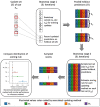A nonparametric updating method to correct clinical prediction model drift
- PMID: 31397478
- PMCID: PMC6857513
- DOI: 10.1093/jamia/ocz127
A nonparametric updating method to correct clinical prediction model drift
Abstract
Objective: Clinical prediction models require updating as performance deteriorates over time. We developed a testing procedure to select updating methods that minimizes overfitting, incorporates uncertainty associated with updating sample sizes, and is applicable to both parametric and nonparametric models.
Materials and methods: We describe a procedure to select an updating method for dichotomous outcome models by balancing simplicity against accuracy. We illustrate the test's properties on simulated scenarios of population shift and 2 models based on Department of Veterans Affairs inpatient admissions.
Results: In simulations, the test generally recommended no update under no population shift, no update or modest recalibration under case mix shifts, intercept correction under changing outcome rates, and refitting under shifted predictor-outcome associations. The recommended updates provided superior or similar calibration to that achieved with more complex updating. In the case study, however, small update sets lead the test to recommend simpler updates than may have been ideal based on subsequent performance.
Discussion: Our test's recommendations highlighted the benefits of simple updating as opposed to systematic refitting in response to performance drift. The complexity of recommended updating methods reflected sample size and magnitude of performance drift, as anticipated. The case study highlights the conservative nature of our test.
Conclusions: This new test supports data-driven updating of models developed with both biostatistical and machine learning approaches, promoting the transportability and maintenance of a wide array of clinical prediction models and, in turn, a variety of applications relying on modern prediction tools.
Keywords: calibration; model updating; predictive analytics.
© The Author(s) 2019. Published by Oxford University Press on behalf of the American Medical Informatics Association. All rights reserved. For permissions, please email: journals.permissions@oup.com.
Figures



Similar articles
-
A closed testing procedure to select an appropriate method for updating prediction models.Stat Med. 2017 Dec 10;36(28):4529-4539. doi: 10.1002/sim.7179. Epub 2016 Nov 28. Stat Med. 2017. PMID: 27891652
-
Detection of calibration drift in clinical prediction models to inform model updating.J Biomed Inform. 2020 Dec;112:103611. doi: 10.1016/j.jbi.2020.103611. Epub 2020 Nov 4. J Biomed Inform. 2020. PMID: 33157313 Free PMC article.
-
Calibration drift in regression and machine learning models for acute kidney injury.J Am Med Inform Assoc. 2017 Nov 1;24(6):1052-1061. doi: 10.1093/jamia/ocx030. J Am Med Inform Assoc. 2017. PMID: 28379439 Free PMC article.
-
Methods for updating a risk prediction model for cardiac surgery: a statistical primer.Interact Cardiovasc Thorac Surg. 2019 Mar 1;28(3):333-338. doi: 10.1093/icvts/ivy338. Interact Cardiovasc Thorac Surg. 2019. PMID: 30608590 Review.
-
Methodological guidance for the evaluation and updating of clinical prediction models: a systematic review.BMC Med Res Methodol. 2022 Dec 12;22(1):316. doi: 10.1186/s12874-022-01801-8. BMC Med Res Methodol. 2022. PMID: 36510134 Free PMC article.
Cited by
-
Prospective Validation of an Electronic Health Record-Based, Real-Time Suicide Risk Model.JAMA Netw Open. 2021 Mar 1;4(3):e211428. doi: 10.1001/jamanetworkopen.2021.1428. JAMA Netw Open. 2021. PMID: 33710291 Free PMC article.
-
Maintaining a National Acute Kidney Injury Risk Prediction Model to Support Local Quality Benchmarking.Circ Cardiovasc Qual Outcomes. 2022 Aug;15(8):e008635. doi: 10.1161/CIRCOUTCOMES.121.008635. Epub 2022 Aug 12. Circ Cardiovasc Qual Outcomes. 2022. PMID: 35959674 Free PMC article.
-
Emerging algorithmic bias: fairness drift as the next dimension of model maintenance and sustainability.J Am Med Inform Assoc. 2025 May 1;32(5):845-854. doi: 10.1093/jamia/ocaf039. J Am Med Inform Assoc. 2025. PMID: 40079820 Free PMC article.
-
Correcting for case-mix shift when developing clinical prediction models.BMC Med Res Methodol. 2025 Aug 1;25(1):186. doi: 10.1186/s12874-025-02621-2. BMC Med Res Methodol. 2025. PMID: 40750843 Free PMC article.
-
Continuous Learning in Model-Informed Precision Dosing: A Case Study in Pediatric Dosing of Vancomycin.Clin Pharmacol Ther. 2021 Jan;109(1):233-242. doi: 10.1002/cpt.2088. Epub 2020 Nov 21. Clin Pharmacol Ther. 2021. PMID: 33068298 Free PMC article.
References
-
- Feldman M, Stanford R, Catcheside A, Stotter A.. The use of a prognostic table to aid decision making on adjuvant therapy for women with early breast cancer. European Journal of Surgical Oncology 2002; 286: 615–9. - PubMed
-
- Amarasingham R, Patzer RE, Huesch M, Nguyen NQ, Xie B.. Implementing electronic health care predictive analytics: considerations and challenges. Health Aff (Millwood) 2014; 337: 1148–54. - PubMed
MeSH terms
LinkOut - more resources
Full Text Sources
Other Literature Sources

